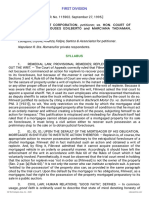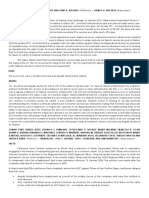Properties of Public Dominion
Properties of Public Dominion
Uploaded by
Aljay DAHANCopyright:
Available Formats
Properties of Public Dominion
Properties of Public Dominion
Uploaded by
Aljay DAHANOriginal Description:
Copyright
Available Formats
Share this document
Did you find this document useful?
Is this content inappropriate?
Copyright:
Available Formats
Properties of Public Dominion
Properties of Public Dominion
Uploaded by
Aljay DAHANCopyright:
Available Formats
Properties of Public Dominion
Art. 422. Property of public dominion, when no longer intended for public use or for public
service, shall form part of the patrimonial property of the State. National Government or any
person authorized by it under a proper contract.
Properties for public use or public service
Article 422 of the Civil Code states that "[p]roperty of public dominion, when no longer intended for
public use or for public service, shall form part of the patrimonial property of the State." It is this
provision that controls how public dominion property may be converted into patrimonial property
susceptible to acquisition by prescription. After all, Article 420 (2) makes clear that those property
"which belong to the State, without being for public use, and are intended for some public service or
for the development of the national wealth" are public dominion property. For as long as the property
belongs to the State, although already classified as alienable or disposable, it remains property of
the public dominion if when it is "intended for some public service or for the development of the
national wealth."
Accordingly, there must be an express declaration by the State that the public dominion property is
no longer intended for public service or the development of the national wealth or that the property
has been converted into patrimonial. Without such express declaration, the property, even if
classified as alienable or disposable, remains property of the public dominion, pursuant to Article
420(2), and thus incapable of acquisition by prescription. It is only when such alienable and
disposable lands are expressly declared by the State to be no longer intended for public service or
for the development of the national wealth that the period of acquisitive prescription can begin to
run. Such declaration shall be in the form of a law duly enacted by Congress or a Presidential
Proclamation in cases where the President is duly authorized by law.
Inalienable Public Lands of Public Domain
All lands not appearing to be clearly within private ownership are presumed to belong to the
State. Accordingly, public lands not shown to have been reclassified or released as
alienable agricultural land or alienated to a private person by the State remain part of the
inalienable public domain
Military installations, civil and quasi-public lands
‘Quasi‐public’ land is the term used to denote land or space which serves a public function but which is privately
owner.
All lands not classified as alienable or disposable
unclassified lands are in the same footing as forest lands because these belong to the State; these
are not alienable and disposable land of public domain; and these are not subject to private
ownership
You might also like
- New South Wales Police Force HandbookDocument287 pagesNew South Wales Police Force HandbookEza Berezza100% (1)
- Magna-Carta Q N ADocument1 pageMagna-Carta Q N ACinderella Rodemio47% (15)
- A.M. No. Mtj-16-1886-Benito, Li Carl T. (Vawc)Document2 pagesA.M. No. Mtj-16-1886-Benito, Li Carl T. (Vawc)licarl benitoNo ratings yet
- Classification of LandsDocument3 pagesClassification of LandsKaren Maechelle EdullantesNo ratings yet
- Property Meralco Steel Towers CaseDocument10 pagesProperty Meralco Steel Towers CaseJelena SebastianNo ratings yet
- Laganapan vs. AsedilloDocument2 pagesLaganapan vs. AsedilloMarry Rose LasherasNo ratings yet
- Case Digest CREDIT TRANSACTIONS FINALSDocument22 pagesCase Digest CREDIT TRANSACTIONS FINALSLatrell Marcus100% (1)
- Hasegawa Vs KitamuraDocument2 pagesHasegawa Vs KitamuraElena TanNo ratings yet
- Accession With Respect To Movable PropertyDocument16 pagesAccession With Respect To Movable PropertyEdward Kenneth KungNo ratings yet
- Heirs of Mario Malabanan vs. Republic of The Philippines: en BancDocument4 pagesHeirs of Mario Malabanan vs. Republic of The Philippines: en BancDuane Kendall Santos LimNo ratings yet
- PALE DagiestDocument76 pagesPALE DagiestPatrice ErniNo ratings yet
- Tantoco Vs Municipal CouncilDocument4 pagesTantoco Vs Municipal CouncilWilliam Christian Dela CruzNo ratings yet
- National Liga NG Mga Barangay Vs Paredes - G.R. No. 130775. September 27, 2004Document13 pagesNational Liga NG Mga Barangay Vs Paredes - G.R. No. 130775. September 27, 2004Ebbe DyNo ratings yet
- Ewoc Vs COMELECDocument2 pagesEwoc Vs COMELECAllan Cj SangkateNo ratings yet
- REVIEWERDocument7 pagesREVIEWERJORDAN MYC VILLAMORNo ratings yet
- 124069-1998-Casabuena v. Court of Appeals20211020-12-1ganzieDocument6 pages124069-1998-Casabuena v. Court of Appeals20211020-12-1ganzieDAISY REE JANE LUPASENo ratings yet
- PIL - Supplementary CasesDocument9 pagesPIL - Supplementary CasesGem AusteroNo ratings yet
- City of Cebu v. NAWASADocument7 pagesCity of Cebu v. NAWASALylo BesaresNo ratings yet
- Case Digest CompilationDocument44 pagesCase Digest Compilationmark87vince24No ratings yet
- Buklod NG Kawaning Eiib Vsexec Sec ZamoraDocument2 pagesBuklod NG Kawaning Eiib Vsexec Sec ZamoraCDMNo ratings yet
- Estate of Litton vs. MendozaDocument12 pagesEstate of Litton vs. MendozadanexrainierNo ratings yet
- D2a - 2 Alcaraz v. Tangga-AnDocument2 pagesD2a - 2 Alcaraz v. Tangga-AnAaron AristonNo ratings yet
- Cordillera v. COADocument2 pagesCordillera v. COAJemson Ivan WalcienNo ratings yet
- De Jesus Vs Sanchez-MAliitDocument6 pagesDe Jesus Vs Sanchez-MAliitRosalie CastroNo ratings yet
- Week 2B - CompiledDocument12 pagesWeek 2B - CompiledKarla BeeNo ratings yet
- CSC vs. DacoycoyDocument1 pageCSC vs. DacoycoySui GenerisNo ratings yet
- Accession - 4. Leviste Management System Inc. vs. Legazpi Towers 200, Inc. GR. No. 199353 April 4, 2018Document15 pagesAccession - 4. Leviste Management System Inc. vs. Legazpi Towers 200, Inc. GR. No. 199353 April 4, 2018Melanie ManatadNo ratings yet
- Pubcorp Case DigestDocument6 pagesPubcorp Case DigestKaren Ryl Lozada BritoNo ratings yet
- Property Case Digests (JM) CompiledDocument47 pagesProperty Case Digests (JM) CompiledJoselle MarianoNo ratings yet
- Republic v. City of DavaoDocument10 pagesRepublic v. City of Davaolovekimsohyun89No ratings yet
- Cordillera Global Network Vs SM Case DigestDocument3 pagesCordillera Global Network Vs SM Case DigestOgie Rose BanasanNo ratings yet
- Jorge Gonzales & Panel of Arbitrators vs. Climax Mining LTD., Climax-Arimco Mining Corp., & Australasian Philippines Mining IncDocument2 pagesJorge Gonzales & Panel of Arbitrators vs. Climax Mining LTD., Climax-Arimco Mining Corp., & Australasian Philippines Mining IncTrudgeOnNo ratings yet
- Bachrach vs. Seifert Facts: HeldDocument44 pagesBachrach vs. Seifert Facts: HeldJustin EnriquezNo ratings yet
- TITLE: Jaboneta vs. Gustilo CITATION: G.R. No. 1641, January 19, 1906 FactsDocument3 pagesTITLE: Jaboneta vs. Gustilo CITATION: G.R. No. 1641, January 19, 1906 FactsKristine JoyNo ratings yet
- 2 Hong Kong and Shanghai Banking Corp. v. Sherman, G.R. No. 72494, Aug. 11, 1989Document5 pages2 Hong Kong and Shanghai Banking Corp. v. Sherman, G.R. No. 72494, Aug. 11, 1989Robert EspinaNo ratings yet
- Reaction Paper - PDF - Sea - PhilippinesDocument8 pagesReaction Paper - PDF - Sea - PhilippinesBarbara Jane CambasNo ratings yet
- Eastern Shipping Lines, Inc. vs. POEA, G.R. No. 76633. October 18, 1988Document5 pagesEastern Shipping Lines, Inc. vs. POEA, G.R. No. 76633. October 18, 1988Mary Divina FranciscoNo ratings yet
- 3 Repulic of The Philippines vs. CA 342 SCRA 189Document7 pages3 Repulic of The Philippines vs. CA 342 SCRA 189Francis LeoNo ratings yet
- Land Titles and DeedsDocument8 pagesLand Titles and DeedsHanabishi RekkaNo ratings yet
- Case Cebu United Enterprises v. Gallofin, 106 Phil 491 (1959)Document6 pagesCase Cebu United Enterprises v. Gallofin, 106 Phil 491 (1959)Clarice Joy SjNo ratings yet
- Alvarado Vs GaviolaDocument6 pagesAlvarado Vs GaviolaEnan IntonNo ratings yet
- Insurance-Digests Complete PDFDocument67 pagesInsurance-Digests Complete PDFDesire RufinNo ratings yet
- How Is The Resolution PreparedDocument1 pageHow Is The Resolution PreparedFran JaramillaNo ratings yet
- Admin Law - Case DigestDocument18 pagesAdmin Law - Case Digestshaina de leonNo ratings yet
- Reparations Commission v. Universal Deep Sea FishingDocument1 pageReparations Commission v. Universal Deep Sea FishingwuplawschoolNo ratings yet
- Admin Case DigestDocument4 pagesAdmin Case DigestJovita Andelescia MagasoNo ratings yet
- The Regalian DoctrineDocument2 pagesThe Regalian DoctrineIrish MartinezNo ratings yet
- Facts:: Civil Procedure Atty. Higino Macabales Mr. Dennis S. JabagatDocument3 pagesFacts:: Civil Procedure Atty. Higino Macabales Mr. Dennis S. JabagatAklanppsmu AppsmuNo ratings yet
- BPI vs. Intermediate Appellate Court GR# L-66826, August 19, 1988Document6 pagesBPI vs. Intermediate Appellate Court GR# L-66826, August 19, 1988Jolet Paulo Dela CruzNo ratings yet
- Mustang Lumber V. Ca: IssueDocument45 pagesMustang Lumber V. Ca: IssueJoshua ParilNo ratings yet
- Casabuena vs. CADocument3 pagesCasabuena vs. CAThoughts and More ThoughtsNo ratings yet
- Arts 457 465 3Document6 pagesArts 457 465 3Rocky YapNo ratings yet
- Pilipinas Shell Petroleum Corp. vs. Oil Industry BoardDocument2 pagesPilipinas Shell Petroleum Corp. vs. Oil Industry BoardLawrence SantiagoNo ratings yet
- Province of Antique Vs CalabocalDocument2 pagesProvince of Antique Vs CalabocalAJ QuimNo ratings yet
- Succession Case Digests No. 1 AmmangDocument8 pagesSuccession Case Digests No. 1 Ammangefren_delapazNo ratings yet
- EvidenceDocument156 pagesEvidenceJade Palace TribezNo ratings yet
- #18 Republic Glass Corp. vs. QuaDocument3 pages#18 Republic Glass Corp. vs. QuaRaymond FaeldoñaNo ratings yet
- Quilala Vs AlcantaraDocument7 pagesQuilala Vs AlcantaraLee SomarNo ratings yet
- Mapa Vs CADocument6 pagesMapa Vs CAIvan Montealegre ConchasNo ratings yet
- LTD PDFDocument7 pagesLTD PDFYoan Baclig BuenoNo ratings yet
- G.R. No. 115902 - Filinvest Credit Corp. v. Court of AppealsDocument11 pagesG.R. No. 115902 - Filinvest Credit Corp. v. Court of AppealsmscNo ratings yet
- Philippine Banking Corporation vs. Lui SheDocument9 pagesPhilippine Banking Corporation vs. Lui SheAmanda ButtkissNo ratings yet
- Land Reg Laws Case DigestsDocument11 pagesLand Reg Laws Case DigestsPaul BasillaNo ratings yet
- Pendot Versus Court of AppealsDocument1 pagePendot Versus Court of AppealsAljay DAHANNo ratings yet
- Shariah 4 - Historical-BackgroundDocument24 pagesShariah 4 - Historical-BackgroundAljay DAHANNo ratings yet
- Rule 45 Vs 65 CertiorariDocument2 pagesRule 45 Vs 65 CertiorariAljay DAHANNo ratings yet
- The Usury LawDocument7 pagesThe Usury LawAljay DAHANNo ratings yet
- Concept of Owner Vs Concept of HolderDocument2 pagesConcept of Owner Vs Concept of HolderAljay DAHANNo ratings yet
- PNB Vs CruzDocument2 pagesPNB Vs CruzAljay DAHANNo ratings yet
- Drugstores Association of The Philippines Inc. Et Al Vs National Council On Disability Affairs Et Al - GR No 194561 - 9.14.16Document12 pagesDrugstores Association of The Philippines Inc. Et Al Vs National Council On Disability Affairs Et Al - GR No 194561 - 9.14.16Ro Jhe LouNo ratings yet
- Criminal-Law-Book-1-Articles-41-50 FinalDocument9 pagesCriminal-Law-Book-1-Articles-41-50 FinalJacket TralalaNo ratings yet
- Highlighted CIR v. Castaneda, G.R. No. 96016, October 17, 1991, 203 SCRA 72.htmlDocument2 pagesHighlighted CIR v. Castaneda, G.R. No. 96016, October 17, 1991, 203 SCRA 72.htmlCharity RomagaNo ratings yet
- Outcomes of Democracy Shobhit NirwanDocument9 pagesOutcomes of Democracy Shobhit NirwanRohit Kumar100% (10)
- Banco de Oro-Epci, Inc. vs. Japrl Development Corporation, Rapid Forming Corporation and Jose U. Arollado G.R. No. 179901 April 14, 2008 FactsDocument2 pagesBanco de Oro-Epci, Inc. vs. Japrl Development Corporation, Rapid Forming Corporation and Jose U. Arollado G.R. No. 179901 April 14, 2008 FactsAdi Lim100% (1)
- TP 1Document3 pagesTP 1Mitch Bea Tonogbanua93% (15)
- What Is Good Corporate GovernanceDocument12 pagesWhat Is Good Corporate GovernanceJelly Anne100% (1)
- LLP Incorporation ProcedureDocument3 pagesLLP Incorporation ProcedureCorproNo ratings yet
- House Hearing, 110TH Congress - Department of Health and Human Services Fiscal Year 2009 BudgetDocument48 pagesHouse Hearing, 110TH Congress - Department of Health and Human Services Fiscal Year 2009 BudgetScribd Government DocsNo ratings yet
- A015 Anti Hazing LawDocument19 pagesA015 Anti Hazing LawLeolaida AragonNo ratings yet
- Congressional Inquiry of Sen Rubio To CFPB Re HECM Reverse MortgageDocument114 pagesCongressional Inquiry of Sen Rubio To CFPB Re HECM Reverse MortgageNeil GillespieNo ratings yet
- BRANDL v. ACE USA Et Al DocketDocument2 pagesBRANDL v. ACE USA Et Al DocketACELitigationWatchNo ratings yet
- HW No. 3Document15 pagesHW No. 3Marco MendenillaNo ratings yet
- 2022 Vito J Fossella Et Al V Eric Adams Et Al Notice of Appeal 180Document46 pages2022 Vito J Fossella Et Al V Eric Adams Et Al Notice of Appeal 180Brigid Bergin100% (1)
- Income Tax in India - Wikipedia, The Free EncyclopediaDocument13 pagesIncome Tax in India - Wikipedia, The Free EncyclopediaAnonymous utfuIcnNo ratings yet
- APOLINARIO AMANDA VALDEZ, G.R. No. 201655 DIGESTDocument3 pagesAPOLINARIO AMANDA VALDEZ, G.R. No. 201655 DIGESTMichael James Madrid MalinginNo ratings yet
- Single Entry Approach Process Flow at The NcrabDocument2 pagesSingle Entry Approach Process Flow at The NcrabJanine Prelle Dacanay100% (1)
- National Land Code 1965++Document17 pagesNational Land Code 1965++Dang Tzer ShiuanNo ratings yet
- Alumni Oath of OfficeDocument11 pagesAlumni Oath of Officegoeb72No ratings yet
- IBP Vs Zamora G.R. No. 141284 August 15, 2000Document19 pagesIBP Vs Zamora G.R. No. 141284 August 15, 2000Kenley MacandogNo ratings yet
- Moran V CADocument8 pagesMoran V CAHudson CeeNo ratings yet
- Public Finance and Fiscal Policy: 5.1 OverviewDocument9 pagesPublic Finance and Fiscal Policy: 5.1 Overviewtech damnNo ratings yet
- Good Governance and Public Policy in India: V Mallika VedanthamDocument12 pagesGood Governance and Public Policy in India: V Mallika Vedanthamdurgesh kumar gandharveNo ratings yet
- NegotiationDocument30 pagesNegotiationvinodshukla25No ratings yet
- Russian History - All Possible Essays Questions With PlansDocument31 pagesRussian History - All Possible Essays Questions With PlansharrybojakowskiNo ratings yet
- Labor 6&7Document2 pagesLabor 6&7Gonzales Juliefer AnnNo ratings yet
- Carpio v. Executive Secretary, 206 SCRA 290 - Presidential Power of ControlDocument7 pagesCarpio v. Executive Secretary, 206 SCRA 290 - Presidential Power of ControlAbegail AtokNo ratings yet































































































